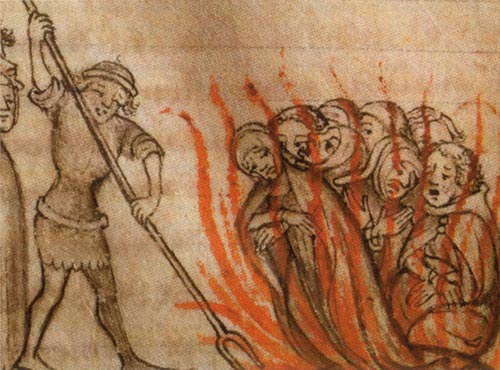Knights Templar Arrested in France
Philip IV had every Templar arrested on October 13th, 1307.
 Has more silly nonsense been written about any institution in history than the Order of Knights Templar? The community of Poor Fellow-Soldiers of Christ and of the Temple of Solomon was founded after the First Crusade to protect Christian pilgrims to the Holy Land. The members swore oaths of poverty and chastity, and their distinctive badge was a red cross on a white mantle. They rapidly gained recruits and grew into medieval Christendom’s leading military order.
Has more silly nonsense been written about any institution in history than the Order of Knights Templar? The community of Poor Fellow-Soldiers of Christ and of the Temple of Solomon was founded after the First Crusade to protect Christian pilgrims to the Holy Land. The members swore oaths of poverty and chastity, and their distinctive badge was a red cross on a white mantle. They rapidly gained recruits and grew into medieval Christendom’s leading military order.
One thing the Templars certainly did not remain was poor. They acquired substantial lands in France, England and Spain. Their efficient military network enabled them to move gold bullion safely and they became rich and powerful as bankers to European kings. By the end of the thirteenth century, however, the Muslims had recovered the Holy Land, which took away the Templars’ original reason for existence.
Philip IV of France, who was short of money, saw an opportunity to make some. He may also have been uneasy about the Templars’ power. He had every Templar in France arrested on the same day in 1307, handed them over to the Inquisition for interrogation and confiscated all the Order’s property in France. In the twelfth and thirteenth centuries various groups of heretics, including the Waldensians and Cathars, had been accused of worshipping the Devil and confessions had been extracted under torture of secret nocturnal meetings with indiscriminate sexual orgies in honour of Satan, renunciation of Christ and desecration of the cross. A similar pattern of accusations was now made against the Templars, who had allegedly worshipped the Devil, denied God, Christ and the Virgin Mary, as well as spitting or urinating on the cross, and engaging in ritual homosexuality.
Those arrested were tortured, pressured and brainwashed until many of them confessed to these abominations. They generally presented themselves to their inquisitors as innocent victims of a system they were powerless to control. Many said that though strictly barred from relations with women, they had been forced (most unwillingly, they emphasized) to submit to homosexual embraces and also made to deny Christ and spit on the cross. A few of the confessions told of worshipping a curious head, sometimes called Baphomet. It was described variously as carved of wood or painted on a beam, bearded, covered with silver or gold leaf, or with four legs.
There is no sensible reason for believing the confessions, which were made in response to leading questions and clearly devised to provoke the maximum shock and disgust all over Europe. Many of the knights afterwards denied their confessions, but in May 1310 fifty-four Templars were burned at the stake in a field outside Paris, after which many of those still alive in prison hastily announced that their confessions had been true after all. Philip eventually pressured the French pope, Clement V, into closing the Order down in 1312. Two years later the Grand Master himself, Jacques de Molay, was burned alive in Paris.
The accusations and confessions surrounded the Templars with an aura of mystery that has lasted ever since. A tradition grew up that in the Holy Land they had imbibed mysterious arcane wisdom, which was long afterwards transmitted to the Rosicrucians, the odder fringes of Freemasonry and modern occult groups. One current theory is that the head called Baphomet was the embalmed head of Christ and another has the Templars as custodians of the Holy Grail, which came to them ultimately by way of Mary Magdalene and which they eventually hid away in Scotland. There is still plenty of money to be made out of the Templars.




